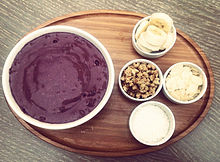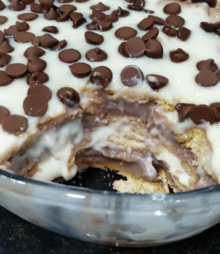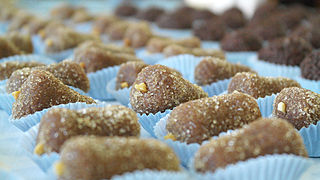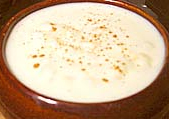 |
| Part of a series on |
| Brazilian cuisine |
|---|
| Types of food |
| See also |
Below is a list of sweets and desserts found in Brazilian cuisine. Brazilian cuisine has European, African and Amerindian influences. It varies greatly by region, reflecting the country's mix of native and immigrant populations, and its continental size as well. This has created a national cuisine marked by the preservation of regional differences.
Desserts and sweets
This is a dynamic list and may never be able to satisfy particular standards for completeness. You can help by adding missing items with reliable sources.A–E



- Açaí na tigela – a Brazilian dish made of frozen and mashed açaí palm fruit, it is served as a smoothie in a bowl or glass.
- Amanteigado – a buttery cookie or biscuit
- Baba de moça [pt]
- Bananada [pt]
- Bem-casado [pt]
- Beijinho – a common Brazilian birthday party candy
- Beijo de mulata
- Bijajica – a cookie
- Biriba or biribinha
- Biroró
- Bolo de rolo – a cake prepared using guava, it is recognized as a national dish by Brazilian law.
- Bolo Souza Leão [pt] – a typical Pernambuco cake
- Bom-bocado [pt] – a coconut torte that is commonly served during Brazil's Independence Day
- Brigadeiro – a traditional Brazilian confectionery
- Broinha de coco – a coconut-based biscuit-like dessert
- Bruaca [pt]
- Cacuanga
- Cajuzinho – a popular sweet made of peanuts, cashew nuts and sugar and is shaped like a tiny cashew
- Camafeu de nozes [pt]
- Canjica – a popular Festa Junina sweet dish prepared using canjica corn
- Carolina [pt] – An éclair-like dessert
- Cartola [pt] – a typical Pernambuco dessert
- Cavaca [pt]
- Chuvisco [pt]
- Cocada – a traditional coconut candy or confectionery found in many parts of Latin America
- Creme de papaya – a frozen dessert
- Cupulate [pt] – a chocolate-like dessert made using cupuaçu instead of cacao
- Curau – a sweet custard-like dessert made from the pressed juice of unripe maize, cooked with milk and sugar
- Cuscuz de tapioca – tapioca couscous, also known as cuscuz branco (white couscous), is a dessert made with tapioca granulada (coarse tapioca starch) and shredded coconut, served with sweetened condensed milk
- Doces Cristalizados
- Doce de abóbora [pt]
- Doce de espécie [pt] – typical dessert of the Northeast Region of Brazil
- Espuma de sapo
F–J
- Fatia de braga
- Fios de ovos – a traditional Portuguese sweet food made of eggs (chiefly yolks), drawn into thin strands and boiled in sugar syrup. They are a traditional element in Portuguese and Brazilian cuisine, both in desserts and as side dishes
- Furrundu
K–O

- Mané-pança
- Mané pelado
- Manjar branco – a pure white Brazilian coconut pudding
- Marmelada de Santa Luzia
- Maria-mole – similar to a marshmallow, its base ingredients are sugar, gelatin and egg whites, and it is usually covered in grated coconut
- Nhá Benta – a chocolate-coated creamy marshmallow also known as teta de nega (Black woman's teat)
- Mugunzá – a porridge made with white de-germed whole maize kernels (canjica), cooked with milk, sugar and cinnamon until tender. Other ingredients are also sometimes used.
- Olho de sogra (Mother-in-law's eye) – a candy
P–T

- Paçoca – a candy made out of ground peanuts, sugar and salt
- Palha italiana [pt] – A Brazilian variant of the chocolate salami, consists of crushed biscuits (usually similar to Marie biscuits) mixed in brigadeiro
- Pão de mel - A little cake made of honey, filled with condensed milk cream and covered with a thin layer of chocolate
- Papo-de-anjo – a traditional Portuguese dessert made chiefly from whipped egg yolks, baked and then boiled in sugar syrup.
- Pastel doce
- Pastel de Santa Clara
- Passion fruit mousse
- Pavê – a dessert similar to Tiramisu made using ladyfingers (known as "champagne biscuits" in Brazil) or a Marie biscuit equivalent, chocolate cream and condensed milk
- Pé de moleque – a candy made using peanuts, jaggery or molasses
- Pudim de leite moça
- Queijadinha – a candy that originated in Portugal, and is common in Brazil
- Quindim – a popular Brazilian baked custard dessert
- Rapadura – unrefined whole cane sugar
- Romeu e Julieta – Goiabada eaten with cheese
- Sweet rice – rice pudding
- Sagu – a southern Brazilian dessert, made with tapioca pearls, sugar and red wine, it is typical of the state of Rio Grande do Sul.
- Torta alemã (lit. 'german pie')
U–Z
Gallery
- Brazilian sweets and desserts
-
 Beijinho
Beijinho
-
 Cajuzinho
Cajuzinho
-
 Canjica
Canjica
-
 Cocada
Cocada
-
 Commercially prepared pé-de-moleque
Commercially prepared pé-de-moleque
-
 Quindim
Quindim
See also
References
- Brittin, Helen (2011). The Food and Culture Around the World Handbook. Boston: Prentice Hall. pp. 20–21. ISBN 9780135074817.
- "Way of Life". Encarta. MSN. Archived from the original on 2009-10-29. Retrieved 2008-06-08.
- "Açaí, a Global Super Fruit, Is Dinner in the Amazon", The New York Times, February 23, 2010
- Tatum, C.M. (2013). Encyclopedia of Latino Culture: From Calaveras to Quinceaneras. Cultures of the American Mosaic. ABC-CLIO. p. 429. ISBN 978-1-4408-0099-3. Retrieved July 5, 2019.
- D, T.G.R.P.; Roufs, K.S. (2014). Sweet Treats around the World: An Encyclopedia of Food and Culture: An Encyclopedia of Food and Culture. ABC-CLIO. p. 399. ISBN 978-1-61069-221-2. Retrieved July 5, 2019.
- Webb, L.S.; Roten, L.G. (2011). Holidays of the World Cookbook for Students: Updated and Revised. ABC-CLIO. p. 332. ISBN 978-0-313-38393-9. Retrieved July 3, 2019.
- Maresch, Gustavo (27 October 2020). "Gastronomia tradicional da Ilha de Santa Catarina: açoriana ou manezinha?". Sistema Catarinense de Comunicações [pt]. Retrieved 6 September 2021.
- Parés, L.N. (2013). The Formation of Candomble: Vodun History and Ritual in Brazil. Latin America in translation / en traducción / em tradução. University of North Carolina Press. p. 288. ISBN 978-1-4696-1092-4. Retrieved July 5, 2019.
- Charles Gordon Sinclair (1998), International Dictionary of Food & Cooking. Taylor & Francis. ISBN 1-57958-057-2, ISBN 978-1-57958-057-5
External links
| Lists of prepared foods | |||||||||||||||||||||
|---|---|---|---|---|---|---|---|---|---|---|---|---|---|---|---|---|---|---|---|---|---|
| Dishes by origin |
| ||||||||||||||||||||
| By type and origin |
| ||||||||||||||||||||
| By type |
| ||||||||||||||||||||
